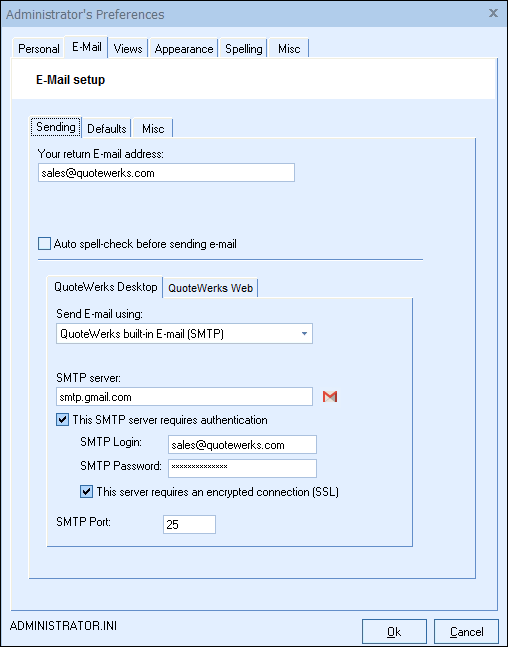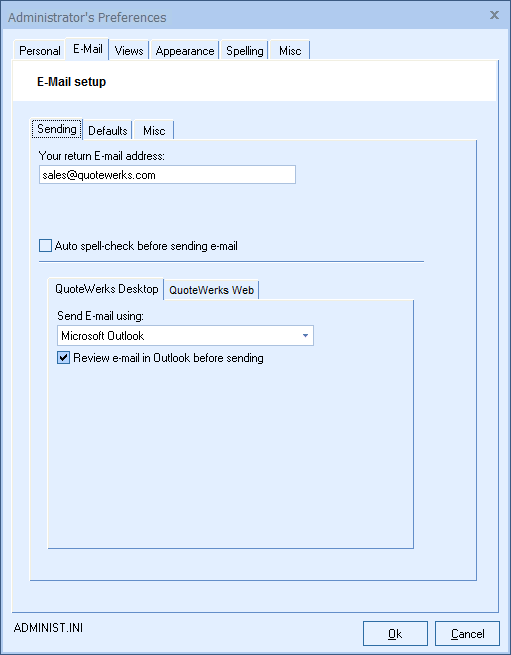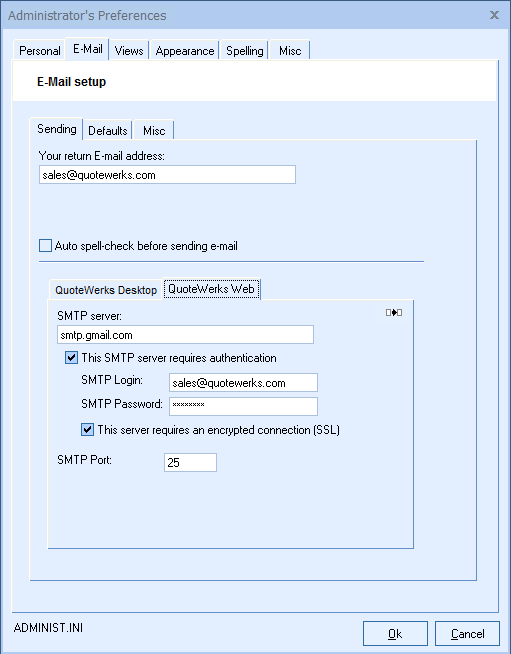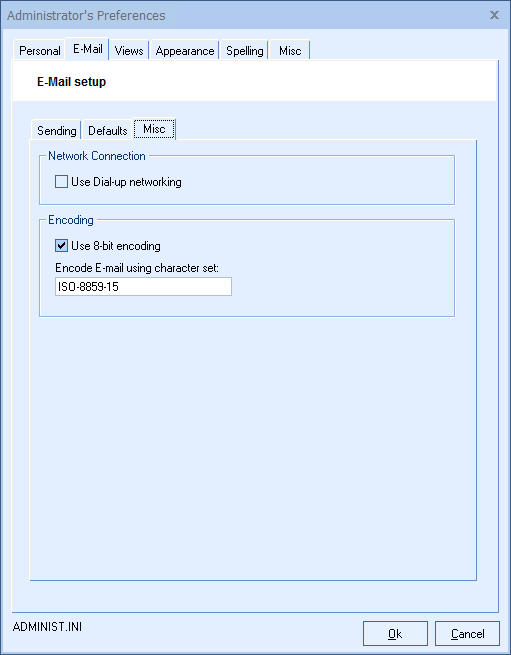QuoteWerks must be set up with the appropriate e-mail settings in order to send e-mails. You can configure the e-mail settings by selecting the E-mail tab of the Tools -> My Preferences menu.

You have two systems available to send your e-mails from within QuoteWerks. QuoteWerks can send e-mails using Microsoft Outlook or the QuoteWerks built-in SMTP e-mail client.
Sending Tab
The following fields are on the Sending tab.
Send E-Mail using
Choose this option to use the built-in QuoteWerks SMTP email. When you select this option, the screen options will change. This is a screenshot of the built-in SMTP settings. If you are using Gmail, you can click on the ![]() icon to automatically load the Gmail SMTP settings.
icon to automatically load the Gmail SMTP settings.
SMTP server
This setting is only required if you use the QuoteWerks built-in SMTP e-mail. If you are using this feature, a valid SMTP server name must be specified. The SMTP server name typically follows the format of: smtp.yourservername.net
This SMTP server requires authentication
Some SMTP servers require a login name and password in order to use them. If your SMTP server has this requirement, you need to check this box and supply the User ID and Password. If for example your SMTP server is a Microsoft Exchange server, you may need to supply a user ID and Password.
This server requires an encrypted connection (SSL)
Some SMTP servers like Google’s Gmail and AT&T mail require an encrypted connection. If your SMTP server requires this, then check this box.
SMTP Port
The default SMTP port on most installations will be 25. This setting may need to be changed on network installations where there is proxy that requires this to be different. Please consult your IT Department for additional information on SMTP ports and proxies.
Choose this option to use Outlook email. When you select this option, the screen options will change. This is a screenshot of the Outlook settings:

Review e-mail in Outlook before sending
This option will create the e-mail in Outlook, and then open Outlook and display the e-mail in Outlook enabling you to review the email, make changes or do whatever you can normally do with an Outlook e-mail.
Your return E-Mail address
When the recipient of your e-mail responds to the e-mail, the e-mail will be sent to this e-mail address. This is most often your e-mail address.
The QuoteWerks Web Tab is where users will specify their email settings if using QuoteWerks Web. You only need to set this up if you are going to use QuoteWerks Web.
Simply enter the settings from your QuoteWerks Desktop tab and add them here or use the ![]() Copy email settings icon to copy the email settings from QuoteWerks Desktop to QuoteWerks Web.
Copy email settings icon to copy the email settings from QuoteWerks Desktop to QuoteWerks Web.

Document Attachment Format
When quotes are e-mailed from within QuoteWerks, the quote is saved into PDF format (Adobe Acrobat compatible) and attached to the e-mail.
Adobe Acrobat PDF Format
The Adobe Acrobat PDF format is an industry standard format that ensures that the recipient views the document in exactly the same format that it was sent in without needing to have the software that created the document. Before Adobe Acrobat, there was no way that a document created in Microsoft Word could be viewed by someone who did not have Microsoft Word installed on their computer. Before Adobe Acrobat, the recipient of your document always had the have the software that you used to create the document. Additionally, the recipient needed to have all the fonts that you had installed on your computer.
When e-mailing your quotes in PDF format, any hyperlink formatted text like www.quotewerks.com or http://www.quotewerks.com will be “clickable” when your customer views the PDF file in Adobe Acrobat and hovers the mouse over the hyperlink.
The PDF format can be opened and printed only by Adobe Acrobat software. In order for the recipient to be able to view and print the quote, they will need to have Adobe Acrobat installed on their computer. Adobe has free Adobe Acrobat Reader software that can be downloaded from their website and installed on the recipient’s computer. Also, now a days, so many programs use Adobe Acrobat, there is also a good chance that your recipient may already have Adobe Acrobat installed on their computer. PDF files cannot be modified by the recipient once they are opened, and depending upon your needs you may want this security.
Auto spell-check before sending email
This check-box will automatically run the spell-checker when you click "Send" on the email window in QuoteWerks without having to start the spell-check manually each time.
Defaults Tab
The following fields are on the Defaults tab.
CC and BCC
On the Defaults tab you can enter the default CC (or BCC) e-mail address to use whenever creating a new e-mail, by entering it here. You can use this to for example always CC the sales manager on all quotes emailed. Additionally, you can use a macro field (like &DH_CustomText01) to have the CC (or BCC) default to an email address that is located in the CustomText01 field on the Custom tab of the Quote WorkBook.
Subject
On the Defaults tab you can enter the default text that will appear whenever creating a new e-mail. You can use QuoteWerks macros to default information like quote number, sold to company name, etc using the green plus icon.
HTML E-Mail Signatures
See E-Mail Signatures.
Misc Tab
The following fields are on the Misc tab.
Network Connection
Uncheck the “Use Dial-up networking” checkbox if you have a full-time internet connection that does not require a dial-up connection.
Encoding
The encoding for the built-in SMTP email encoding can be specified. You can choose to select the "Use 8 bit encoding" option, and you can also specify the "Encode E-mail using character set" setting. For example, to support the German Umlaute characters, you would check the "8 bit" option and type in the character set of "iso-8859-15".

Related Topics: